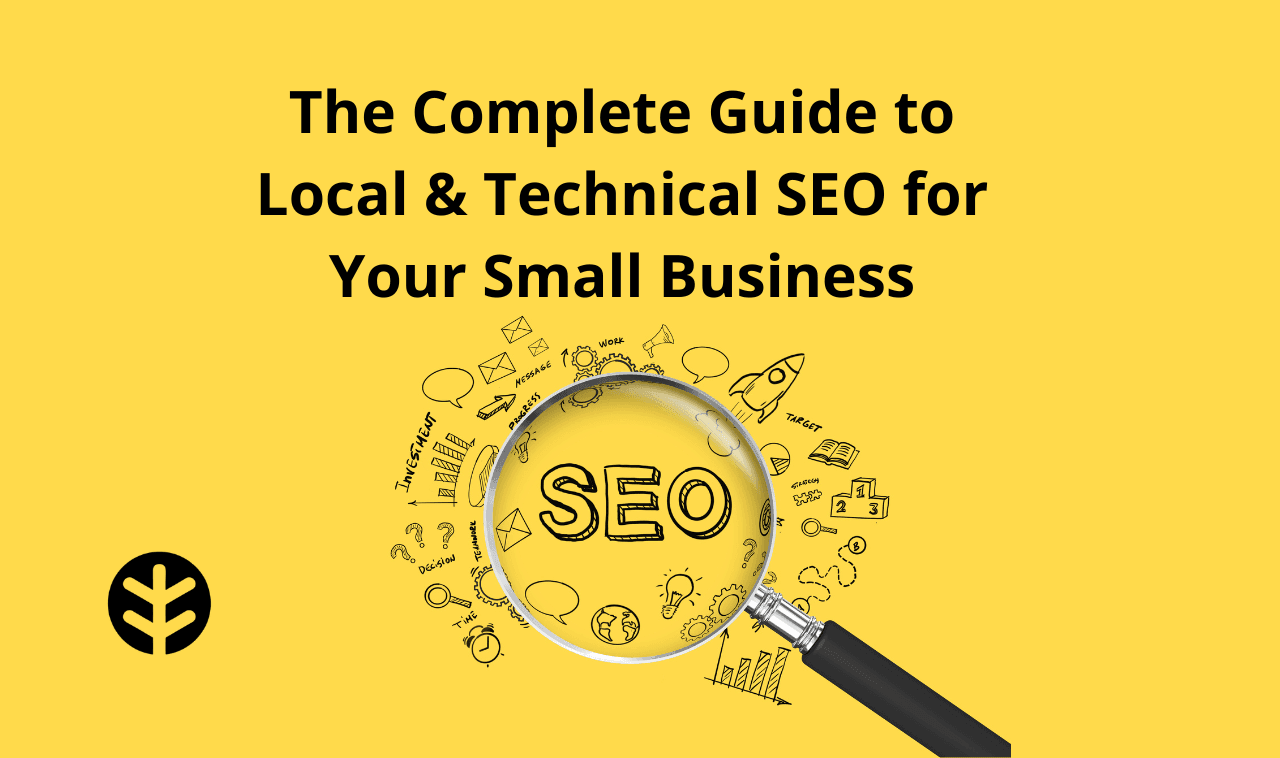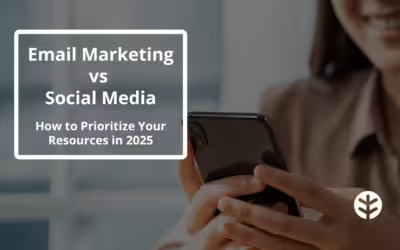No matter what type of wellness business you have, if you’re looking to expand your digital footprint, understanding the basics of SEO is crucial.
There are certain aspects of local SEO that you need to know. Our goal is to empower you, the small business owner, with the knowledge and tools to compete effectively in the digital marketplace. From optimizing your website for better visibility to building a sustainable online presence – let’s dive in.
Getting Started with SEO for Your Small Business
What is SEO in the first place? Search Engine Optimization (SEO) is the practice of optimizing your website to increase its visibility when people search for products or services related to your business in search engines – most importantly, Google.
The goal of SEO is to enhance both the quality and quantity of website traffic, as well as exposure to your brand, through non-paid (also known as “organic”) search engine results.
To get the most out of your SEO efforts, you’ve got to understand what people are searching for online, the answers they want, the words they’re using, and the type of content they wish to consume. Knowing all this allows you to connect with the right people.
For a small business, there are two areas of SEO that you should really focus on: local and technical.
Local SEO vs Technical SEO
While SEO is about optimizing your site for search engines in general, local SEO focuses on attracting local customers, and technical SEO ensures that your site meets the technical requirements of modern search engines for improved crawling and indexing.
Key Components of Local SEO
- Google Business Profile Optimization: This is crucial for local SEO. It involves claiming your Google Business listing, ensuring your information is accurate and comprehensive, and regularly updating it with posts and offers.
- Local Keywords: Incorporating keywords that specify your local area. For instance, if you’re a meditation teacher in Austin, Texas, you would want to include phrases like “meditation in Austin” in your content.
- Local Link Building: This involves getting links from local websites, like local directories, newspapers, or partnerships with other local businesses.
- Reviews and Ratings: Encouraging customers to leave reviews on your Google Business Profile and other relevant online directories. Positive reviews can significantly impact your local search rankings.
- On-Page Local SEO: Ensuring that your website mentions your local area in key places like titles, headers, and body content.
Key Components of Technical SEO
- Website Speed: Ensuring your website loads quickly, as search engines favor fast-loading sites.
- Mobile-Friendliness: With the increasing use of mobile devices, having a mobile-responsive website is crucial for ranking well.
- Structured Data: This is about marking up your website’s code in a way that search engines can understand. It helps in better indexing and can lead to better search result presentations.
- XML Sitemap and Robots.txt: An XML sitemap lists a website’s important pages, making sure Google can find and crawl them all. Robots.txt tells search engines which pages on your site to crawl and which not to crawl.
- Logical Site Structure: Ensure people and search engines can easily navigate your site and understand what you do.
Is SEO Worth It For a Small Business?
Yes, it is definitely worth it for small businesses. Here are several reasons why:
- Increased Visibility and Traffic
- Cost-Effective Marketing
- Builds Credibility and Trust
- Local Engagement
- Compete with Large Businesses
- Adaptable to Market Changes
- Supports Other Marketing Efforts
The investment in SEO is not just about being found online. It’s about establishing a strong digital presence, building credibility, and staying competitive in an increasingly online world.
The key is to have a clear strategy and focus on achievable goals relevant to your specific business needs.
Boost Your Business's Online Visibility
Download our Local SEO Checklist for Small Businesses to jumpstart growth today!
Local SEO in 4 Simple Steps
Local SEO is a subset of SEO that focuses on optimizing a business’s online presence to attract more business from relevant local searches. These searches take place on Google and other search engines. It’s especially important for businesses that have a physical location or serve a specific geographic area.
Here are 4 steps you can take to optimize your website for local traffic today.
Step 1: Establish a Website
This is obvious. If you don’t have a website, this is the first step to establishing your digital footprint.
Creating a website may seem like a daunting task, but it doesn’t have to be. Include a few critical pages and ensure user-friendliness. But there are very simple website builders out there that don’t require any tech skills or experience, like OfferingTree.
You don’t need to have a massive website with hundreds of pages either, there are just a few critical pages you need to have:
Home Page
- Purpose: Serves as the first impression of your business.
- Essential Elements: Clear value proposition, brief introduction to your services or products, easy navigation to other sections of the site.
Schedule Page
- Purpose: Allows clients and potential clients to see your availability and class schedule
- Essential Elements: Clearly structured schedule that is easy to navigate and understand
About Us Page
- Purpose: Tells your story and builds a connection with your audience.
- Essential Elements: Company history, team member bios, company values, and mission statement.
Products/Services Pages
- Purpose: Details what you offer.
- Essential Elements: Descriptions of products or services, pricing, photos or graphics, unique selling points.
Contact Page
- Purpose: Allows customers to get in touch with you.
- Essential Elements: Contact form, phone number, email address, physical location (if applicable), social media links.
Privacy Policy Page
- Purpose: Legal requirement that outlines how customer data is used and protected.
- Essential Elements: Information on data collection, usage, cookies, and third-party data sharing.
Terms of Service Page
- Purpose: Outlines the rules and guidelines for using your website.
- Essential Elements: Use of website content, copyright information, and disclaimer of liabilities.
Each page should be crafted with strong calls to action and tailored to your specific audience and business goals, ensuring that it provides valuable information and encourages engagement and conversion.
See for yourself how OfferingTree stacks up against other website builders like Wix and Squarespace.
Step 2: Create a Google Business Account & Optimize Your Profile
A Google Business Profile (formerly known as Google My Business) is a free tool provided by Google for businesses to manage their online presence across Google, including Search and Maps.
By creating and optimizing a Google Business Profile, businesses can help customers find them more easily and tell them the story of their business.
How to Optimize Your Google Business Profile
- Complete Every Section: Fill out every part of your Google Business Profile. The more complete your profile, the higher Google ranks you in search results.
- Choose the Right Business Category: Select the most accurate category for your business. This helps Google show your business for the right searches.
- Include Keywords: Use relevant keywords in your business description that potential customers might use to find your services or products.
- Add Photos and Videos: Businesses with photos receive more requests for directions and more clicks through to their websites.
- Manage and Respond to Reviews: Encourage customers to leave reviews. Respond promptly and professionally to all reviews, both positive and negative, as this shows that you value customer feedback.
- Keep Information Up to Date: Regularly check your profile to ensure all information is current, especially your hours of operation, contact information, and website link.
- Enable Messaging: Turn on the messaging feature to allow customers to directly message your business from the Google Business Profile. This can improve engagement.
- Utilize the Q&A Feature: Monitor and answer questions in the Q&A section of your profile. You can also proactively post FAQs.
- Verify Your Listing: Ensure your business is verified on Google. This process gives your business legitimacy and improves your visibility.
Step 3: Identify How People Are Searching for Services Like Yours
Identifying how people are searching for local services through keyword research and implementing those keywords into your website involves several steps. This process is crucial for optimizing your local SEO efforts.
How to Identify Local Keywords
Understand Your Audience
- Start by understanding your target audience’s needs, preferences, and language. Consider what services they are looking for and how they might phrase their searches.
Use Keyword Research Tools
- Utilize tools like Google Keyword Planner, SEMrush, Ahrefs, or Moz Keyword Explorer. These tools can provide data on search volume, competition, and variations of keywords.
- Focus on keywords that include local identifiers, such as city names, neighborhoods, or region-specific terms.
Analyze Competitors
- Look at what keywords your competitors are targeting, especially those that rank well in local searches.
- Tools like SEMrush or Ahrefs can help you see which keywords your competitors are ranking for.
Check Google’s Autocomplete and Related Searches
- Type your primary service into Google and see what autocomplete suggestions come up.
- Look at the related searches at the bottom of Google’s search results for additional ideas.
Utilize Local Forums and Social Media
- Explore local forums, social media groups, and community boards to see how people in your area talk about and search for the services you offer.
How to Implement Keywords
- Homepage and Service Pages: Incorporate local keywords naturally into the text of your homepage and main service pages. Include them in titles, headers, meta descriptions, and body content.
- Blog Content: Create blog posts that address local issues, events, or topics related to your service. Use local keywords where they fit naturally.
- Meta Titles and Descriptions: Ensure each page’s meta title and description includes relevant local keywords. These elements are crucial for search engine rankings and click-through rates.
- Google Business Profile: Use local keywords in your Google Business Profile description and posts.
- Alt Tags for Images: Include local keywords in the alt text of images, especially those that are relevant to your location or services.
- Internal Linking: Use local keywords as anchor text when linking internally to other relevant pages on your site.
- Monitor and Adapt: Regularly review your website’s performance. Tools like Google Analytics and Google Search Console can help you understand how visitors find your website and interact with it.
Step 4: Create High-Quality, Helpful Content Related to Your Services
Creating high-quality SEO content for a local business is a strategic process that involves understanding your audience, focusing on local relevance, and providing valuable information.
Here are some basic guidelines to follow:
Understand Your Audience
- Identify Customer Needs: Understand the problems, questions, and interests of your local audience. What are they searching for? What solutions can your business provide?
- Local Insights: Gather insights about local preferences, trends, and language nuances. This can be done through customer interactions, local forums, or social media.
Keyword Research
- Local Keywords: Use keyword research tools to find local search terms relevant to your business. Include geographic terms (city, neighborhood names) in your keywords.
- Long-Tail Keywords: Incorporate long-tail keywords that are more specific and less competitive. They often have a higher conversion rate.
Content Topics and Types
- Relevant Topics: Develop content around topics that matter to your local audience. This could include local issues, events, or how your services/products relate to local needs.
- Diverse Formats: Use various content formats like blog posts, videos, infographics, and guides. For instance, a local restaurant might post recipes, cooking tips, or behind-the-scenes videos.
Localize Your Content
- Community Engagement: Share stories or content involving local events, charities, or activities your business participates in.
- Local Success Stories: Showcase testimonials and case studies from local customers.
- Local Expertise: Position your business as a local expert. For example, a real estate business could provide advice on the local property market.
Optimize for SEO
- Keyword Placement: Include local keywords in titles, headers, meta descriptions, and throughout the content naturally.
- Internal Linking: Link to other relevant pages on your site to keep users engaged and distribute page authority.
- Mobile Optimization: Ensure your content is mobile-friendly, as a significant portion of local searches are done on mobile devices.
Engaging and Readable Content
- Quality Writing: Write clearly, engagingly, and professionally. Avoid jargon and complex language.
- Visual Elements: Use images, videos, and infographics to break up text and enhance engagement.
- Call-to-Action: Include clear calls-to-action (CTAs) encouraging readers to contact you, sign up, or take another specific action.
Update Regularly
- Fresh Content: Regularly update your site with new content to keep it relevant and engaging.
- Seasonal Topics: Capitalize on seasonal trends or events in your area.
Track Performance
- Analytics: Use tools like Google Analytics to track how your content is performing. Look at metrics like page views, time on page, and conversion rates.
- Feedback: Gather feedback directly from your audience through comments, surveys, or social media interactions.
Remember, the goal of high-quality SEO content for a local business is not just to rank well in search engines but also to provide genuine value to your local community, build trust, and establish your business as a local authority in your field.
Get SEO Tips from Expert Meg Casebolt
Watch a webinar we created with our partner & SEO expert Meg Casebolt
Technical SEO Checklist
Technical SEO refers to the process of optimizing the infrastructure of your website so that search engines can crawl and index it more effectively. It’s not about the content of the website but about its setup and structure.
Here is a checklist of the most important technical SEO tasks you should complete.
Website Speed Optimization
- Compress images and use appropriate file formats.
- Minimize HTTP requests (reduce the number of elements on your page).
- Use browser caching.
- Optimize CSS and JavaScript files.
- Consider a Content Delivery Network (CDN) if your audience is global.
Mobile-Friendly Website
- Ensure your website is responsive on all devices.
- Test your site’s mobile usability using Google’s Mobile-Friendly Test.
Secure Website with HTTPS
- Obtain and install an SSL certificate.
- Ensure all pages are served over HTTPS.
Create and Optimize XML Sitemap
- Create an XML sitemap.
- Submit your sitemap to Google Search Console.
Implement Structured Data Markup
- Use schema.org markup to provide search engines with detailed information about your business.
Optimize Robots.txt
- Ensure your robots.txt file is correctly configured to allow search engines to crawl important pages.
Check and Improve Site Architecture
- Ensure a logical hierarchy and clear navigation.
- Keep important pages within a few clicks from the homepage.
Fix Broken Links and Errors
- Regularly check for and fix broken links (404 errors).
- Correct any server errors (5xx errors).
Check for Duplicate Content
- Use tools to identify and resolve any duplicate content issues. When you have duplicate content, Google won’t rank either page.
Accessibility Compliance
- Ensure your website is accessible to users with disabilities.
Remember, technical SEO is an ongoing process. Regularly reviewing and updating your website based on these tasks can significantly improve your site’s performance and search engine rankings.

Embrace the Power of SEO with OfferingTree
SEO is not a one-time effort; it’s an ongoing journey. As your business grows and evolves, so should your SEO strategies. This is where OfferingTree steps in to simplify your journey.
With OfferingTree, you have a partner who understands the unique needs of small businesses and provides the tools and support to make your SEO efforts more effective and less overwhelming.
Experience the difference OfferingTree can make for your business. Sign up now for a two-week free trial and discover how our platform can streamline your SEO efforts, leaving you more time to focus on what you do best – running your business.




![How to Ask Customers for Reviews [with Email Templates]](https://www.offeringtree.com/wp-content/uploads/2021/10/how-to-ask-for-customer-reviews-cover-image-400x250.avif)



